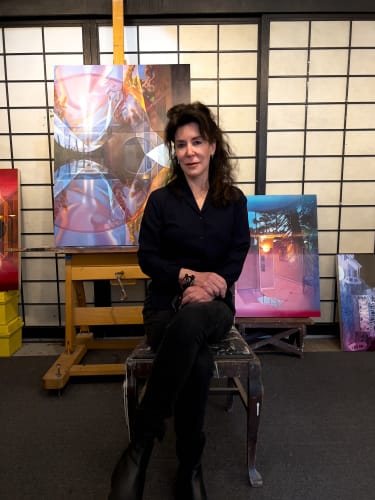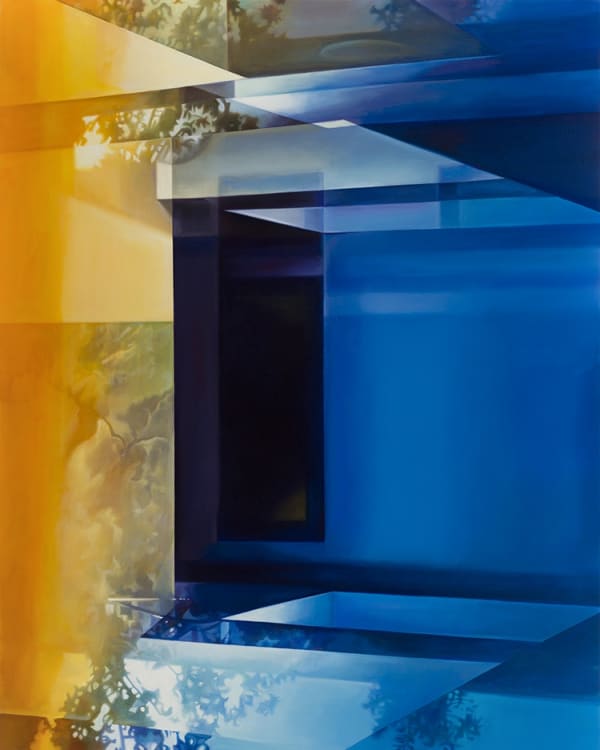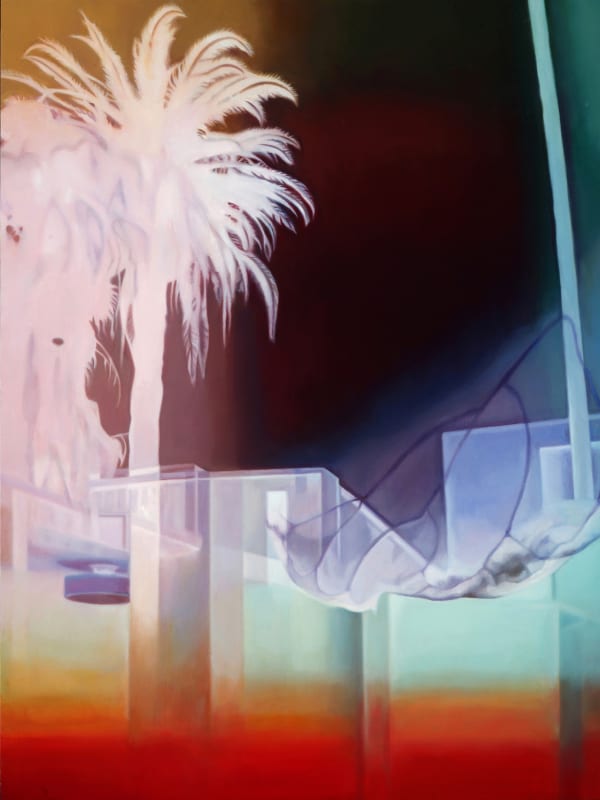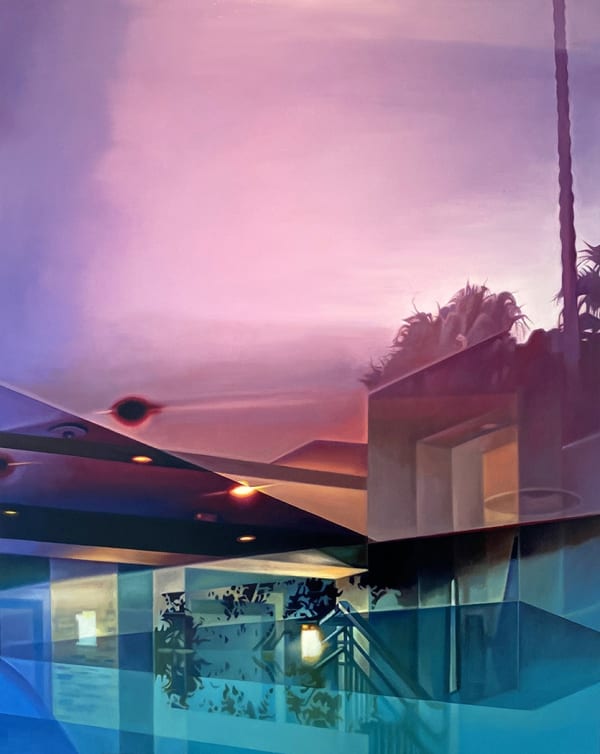Patti Oleon is a painter who lives and works in San Francisco. Her work focuses on light and the tenuous nature of appearances. She works from her photographs of public interior spaces, devoid of human presence, manipulating and layering them digitally to use as a blueprint to create haunting and amorphous paintings. The final paintings are an amalgam of contradictions, blurring the line between the real and the artificial, the dark and the light, and the banal and the transcendent. She uses traditional Old Master oil painting techniques to create works that reference the past, yet are firmly rooted in the present.
Oleon received both her B.A. and M.F.A from UCLA, from which she graduated Phi Beta Kappa and summa cum laude. Her work has been included in many solo and group shows throughout the US. She has been the recipient of numerous awards and grants, including the Guggenheim Foundation Grant, Pollock Krasner Foundation Grant, the Adolph and Esther Gottlieb Foundation Grant, Fulbright/DAAD Fellowship, Ford Foundation Grant, and an Ingram Merrill Foundation Grant.
- CURA ART
-
INTERVIEW
How would you describe your practice in 3 words?
My practice is painting, but in addition, here's three words:
Interiors
Ambiguous
Disorientating
If you could have dinner with any artist from any time:
a) What would the meal be?
Cheeses - Cave Aged Gruyere, English Stilton, Italian Tallegio, French Camembert etc, with fresh sourdough or french baguettes and fine red wine.
I'd pick cheeses, grapes, bread and wine because I love cheese! - but also because it's easy to eat while having a conversation -
b) Whom would the artist be?
Leonardo da Vinci, Jan van Eyck, Vermeer or Hieronymus Bosch
c) Why?
There are too many amazing artists to list that I would love to have dinner with! But when I think about this question, and want something a bit more obscure and farther back in time, but fascinating and mysterious, I'd have to say Leonardo Da Vinci, Jan van Eyck, Vermeer, Hieronymus Bosch-!I am fascinated with Da Vinci the person and the artist, because of his intellect, his creativeness, his imagination, and his consummate skill as a painter. As a human being, artist and inventor, he was transcendent. His mind was so rich and his thinking so original and varied. And Hieronymus Bosch because he was absolutely wild and brilliant! What must he have been like as a person to talk with? Jan Van Eyke because of his obsessive and exquisite rendering of the times that he lived in, the people, the clothing, the interiors. You can step into those places. and Vermeer because of his mastery of light and the quietness of introspection and the moment caught in time of that particular place and person. I think of his work as a model for mine -
I’ve seen your works described as dislocations and amalgams of incidents, places and memories. Could you tell me a bit about what you are trying to say through your practice?
I am interested in the intersection of perception, the built and natural environment and art, and making paintings that not only question the conventions of the landscape and cityscape in art but test out new possibilities for the genre in an age of digitally mediated experiences of nature and the built environment. And the idea of a lobby, which is the basis of the imagery in my paintings, brings so many myriad possibilities to the viewer - Lobbies are entrances, places to pass through on your way to somewhere else, places to rest, places to wait, places to meet, to collect mail, a no-where land.
Because I photograph the interiors from the outside through glass doors on the street, and utilize images from the street to float over and obscure and shift the view, these events all create paintings that are difficult to decipher - you can't tell what is real and what is not. I want the viewer to be perplexed but fascinated about what they are seeing, something that appears very real, but is clearly not. It's about questioning things we take for granted in our day to day life of what "reality" is. I'm also really interested in making paintings that are highly representational (even "photo realistic") but that are on the verge of abstraction.
A couple of years ago, I started using "variants", a tool in Photoshop which lays a semi transparent color across the image, and this added a dreamlike element to my paintings, which enhances (for me) the sense that they are also not really real; memories, dreams. It takes you to another place.
That's beautiful. Thank you for sharing that with me. So I wonder, how do each of your works come to be?
I take hundreds of digital photos - just on my iphone which I always have with me! If I'm walking around anywhere, really, and see something I find interesting, a strange play of light, something that calls into question what it actually is, I take photos. I take multiple photos of the same place, because the idea of layering one on top of another and another also is a way to obscure and confuse and add meaning and mystery to something banal. I always look into lobbies of buildings as I pass to see if there's something unusual about it. Usually it's a play of light. I would say that light plays a pivotal part in all my work, because light both illuminates something to call it into being and light can obscure it, hide it, transform it in innumerable ways. It tricks you.
-
What is the role of photography in your work?
Huge. I use digital photographs as the basis for all my work.
Tell me a bit more about your apartment lobby series. What significance does the location of LA play in your work?
Most of the paintings in the beginning of this series were taken from photos from the area I grew up in - in West LA, including the apartment building my parents lived in for 30 years before they died. So there's a vestige of them, of my childhood, of a quintessential part of LA in the past, (especially the 1970s), which somehow relates to Hollywood. The fake grandiosity of Hollywood haunted my childhood. These lobbies are banal, but sometimes very ornate and almost always kitschy, and are a weird combination of an attempt to install prestige when there is none. It's a longing, I think.
Tell me a bit about your current exhibition with the incredible CURA Art.
Cura curated a group exhibition of artists to be seen in the context of someone collecting art who lives with their collection in their day to day life - it's part of their home, as well as their love for these acquisitions. The art lives with the windows, furniture, lighting, etc.
Who are your favourite contemporary artists?
Nicole Eisenman #niceisenman
Gerhard Richter #gerhard.richter
Whitney Bedford #whitneybedford
James Casebere #jamescasebere
Lisa Yuskavage #lisayuskavage
Wolfgang Tillmans #wolfgang_tillmans
Peter Doig #/peterdoig
Andreas Gursky #andreasgursky
Sayre Gomez #_sayre_gomez_
Alison Elizabeth Taylor #alisonelizabethtaylor
Adrian Ghenie #adrian.ghenie
Lesley Vance #lesleyvanceWhat one song should be added to the She Curates playlist?
"I Feel Like Going Home" by Yo La Tango
Is there anything else you would like to add?
I take a familiar place, a lobby or some banal ubiquitous place that is set up to appear as if it is lived in in a sense, but is void of human presence, and make it disorienting, unplaceable and hopefully mesmerizing











